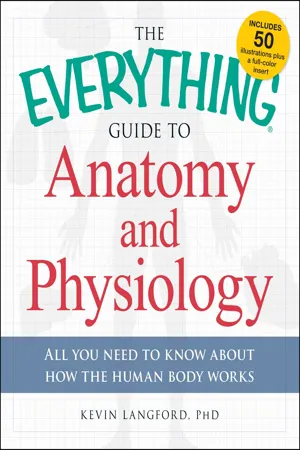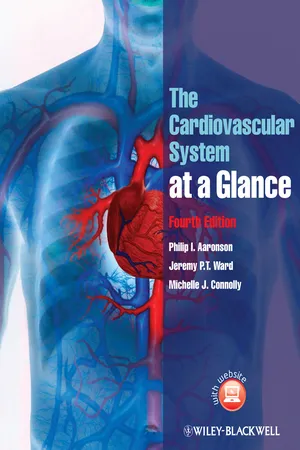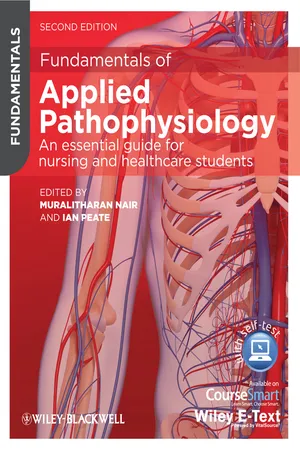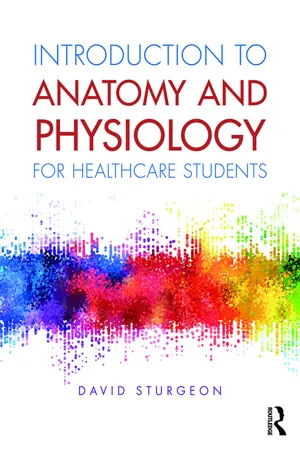Biological Sciences
Blood
Blood is a vital bodily fluid that transports oxygen and nutrients to cells and removes waste products. It consists of red blood cells, white blood cells, platelets, and plasma. Red blood cells contain hemoglobin, which binds to oxygen, while white blood cells play a key role in the immune system, and platelets are essential for blood clotting.
Written by Perlego with AI-assistance
Related key terms
10 Key excerpts on "Blood"
- eBook - ePub
Blood
Physiology and Circulation
- Britannica Educational Publishing, Kara Rogers(Authors)
- 2010(Publication Date)
- Britannica Educational Publishing(Publisher)
CHAPTER 1 THE FLUID OF LIFEB lood is a fundamental component of human life. Within the adult body, approximately 4 to 5 litres (1 to 1.3 gallons) of Blood circulates continuously through an intricate network of vessels, driven by the powerful contractions of the beating heart. As Blood moves away from the lungs and heart, passing through large arteries and winding into increasingly narrower and more complex networks of small vessels, it comes into contact with the individual cells of tissues. At this level, its primary function is to feed these cells, delivering to them a multitude of nutrients, including oxygen—the most basic element necessary for human survival—which it has been carrying since its departure from the lungs. In exchange for these beneficial nutrients, Blood picks up and carries away cellular wastes, such as carbon dioxide, that will ultimately be removed from the body as the Blood travels back to the lungs.The basic components of Blood consist of specialized cells and fluids. Each of these components performs one or more well-defined functions physiologically, and each can be isolated and tested in a laboratory, thereby providing vital information about a person’s health. Indeed, Blood is one of the most easily accessed and readily examined tissues of the human body. Blood analysis has played a key role in the diagnosis of disease as well as the success of multiple lifesaving procedures, including Blood transfusions and bone marrow transplantations. Although much is known about Blood, it remains a subject of intense scientific investigation, fueled especially by the desire for an improved understanding of the role of white Blood cells in pathological processes and in defense against infection.The heart’s forceful contractions propel Blood through the body. Veins carry Blood to the heart and lungs, where oxygen is replenished before arteries pump it back through the body. - eBook - ePub
The Everything Guide to Anatomy and Physiology
All You Need to Know about How the Human Body Works
- Kevin Langford(Author)
- 2015(Publication Date)
- Everything(Publisher)
Chapter 11
Blood
While the cardiovascular system may be thought of as the interstate highway system of the body, the Blood and its many components are most definitely the vehicles, carriers, transporters, and workers that keep the body supplied with essential materials. The Blood volume of an average adult is approximately 5.5 liters (L), and will contain millions of cells and other molecular components. Additionally, some of these components act as garbage trucks, which remove wastes so that living areas can remain clean and healthy. In this section, the components of the Blood will be identified, their functions described, and their roles in body defense and repair explained.Plasma
When most people think of Blood, their first thought is of red Blood cells. In fact, these cells and other formed elements of the Blood make up a smaller percentage of total Blood volume when compared to the liquid portion of Blood: the plasma . For an average adult, the plasma comprises 55 percent of the total Blood volume, and as with the rest of the body, it is primarily composed of water. In addition, the plasma contains dissolved gases, charged ions such as sodium and potassium, fats, carbohydrates, vitamins, minerals, and proteins.Blood elements have been separated by density to show the proportion of the Blood that is red Blood cells, white Blood cells, and platelets.Albumin
The most abundant materials dissolved in plasma are the plasma proteins. Albumin, which is produced in the liver, makes up the bulk of plasma proteins and serves primarily as the “stuff” in the plasma. Albumin acts as a solute in the Blood. In this way, albumin ensures that more protein (stuff) will be present in the Blood stream when compared to the outside of the Blood vessel. This creates an osmotic pressure imbalance that will cause water to be drawn out of the tissue of the body and into the Blood. When proteins, rather than ions, salts, or other materials, function as solutes, the water-drawing force is referred to as colloid osmotic - eBook - ePub
Essential Physiological Biochemistry
An Organ-Based Approach
- Stephen Reed(Author)
- 2013(Publication Date)
- Wiley(Publisher)
5
Biochemistry of the Blood and the vascular system
Overview of the chapterBlood is mostly water in the form of plasma, but the cellular components may reasonably be seen to constitute a tissue even though they do not form a solid organ. Blood vessels regulate Blood pressure in response to hormonal and neural signals and the endothelial cells that line the vessels synthesize a number of important local hormones such as nitric oxide and prostanoids. All Blood cells are produced from the same origin before dividing into eryhtropoietic and leucopoietic lines. Haemoglobin within erythrocytes (red Blood cells) is not only a transport protein for oxygen but also an effective pH buffer. White Blood cells are involved with defence mechanisms through phagocytosis and secretion of chemical signals. Lipoprotein particles are transported through the Blood plasma and are intimately implicated with one of the major pathologies of the twenty-first century, cardiovascular disease such as atherosclerosis.Key pathwaysNitric oxide and eicosanoid synthesis; haem synthesis. The importance of the pentose phosphate pathway reduced glutathione in maintaining red cell integrity. The respiratory burst in phagocytes. Clotting and complement enzyme cascades. Metabolism of lipoproteins.5.1 Introduction
Blood is a unique tissue in that it is (obviously) a fluid. A typical 70 kg adult male has about 5 l of whole Blood coursing his vasculature at any time. The dynamics of the Blood-vascular system are impressive: many millions of cells are released from the bone marrow each day; a red cell will travel over 250 miles (400 km) during its relatively short life span (120 days), and an endothelial cell lining the lumen of a Blood vessel will survive the constant pounding of the Blood surging through the vascular system and remain functional for many months or even years.Blood is the transport medium of the body. Plasma, which accounts for approximately 60% of the total volume, carries a wide range of small and medium-sized metabolites; some are simply dissolved in solution (93% of the plasma is water), others are carried by specific carrier proteins. The chemical composition of the plasma is complex and reflects the chemical composition inside cells, which is why Blood tests are so commonly used in diagnosis to ‘see’ the biochemical events occurring in tissues. The formed cellular elements of the Blood perform several functions: defence against Blood loss from bleeding (platelets, also called thrombocytes), defence against infection and immune surveillance (white cells, leucocytes), and gas transport and pH buffering (red cells, erythrocytes). - eBook - ePub
- Philip I. Aaronson, Jeremy P. T. Ward, Michelle J. Connolly(Authors)
- 2020(Publication Date)
- Wiley-Blackwell(Publisher)
Blood and body fluidsChapters
- Constituents of Blood5
- Erythropoiesis, haemoglobin and anaemia6
- Haemostasis7
- Thrombosis and anticoagulants8
- Blood groups and transfusions9
Passage contains an image
5 Constituents of BloodBlood cell centrifugation and PCVFigure 5.1Composition of plasmaFigure 5.2Protein composition of plasmaFigure 5.3Erythrocytes (red cells)Figure 5.4Relative proportion of leucocytes (total count ~ 4‐11 x 109 per litre)Figure 5.5The primary function of Blood is to deliver O2 and energy sources to the tissues and to remove CO2 and waste products. It contains elements of the defence and immune systems, is important for regulation of temperature, and transports hormones and other signalling molecules between tissues. In a 70‐kg man Blood volume is ~5500 mL, or 8% of body weight. Blood consists of plasma and Blood cells. If Blood is centrifuged, the cells sediment as the packed cell volume (PCV, haematocrit), normally ~45% of total volume (i.e. PCV = 0.45) in men, less in women (Figure 5.1 ).Plasma
The plasma volume is ~5% of body weight. It consists of ions in solution and a variety of plasma proteins. Normal ranges for key constituents are shown in Figure 5.2 . After clotting, a straw‐coloured fluid called serum remains, from which fibrinogen and other clotting factors have been removed. The relative osmotic pressures of plasma, interstitial and intracellular fluid are critical for maintenance of tissue cell volume and are related to the amount of osmotically active particles (molecules) per litre, or osmolarity (mosmol/L); as plasma is not an ideal fluid (it contains slow diffusing proteins), the term osmolality (mosmol/kg H2 O) is often used instead. Plasma osmolality is ~290 mosmol/kg H2 O, mostly due to dissolved ions and small diffusible molecules (e.g. glucose and urea). These diffuse easily across capillaries, and the crystalloid osmotic pressure they exert is therefore the same either side of the capillary wall. Proteins do not easily pass through capillary walls and are responsible for the oncotic (or colloidal osmotic) pressure of the plasma. This is much smaller than crystalloid osmotic pressure but is critical for fluid transfer across capillary walls because it differs between plasma and interstitial fluid (see Chapter 21 ). Oncotic pressure is expressed in terms of pressure and in plasma is normally ~25 mmHg. Maintenance of plasma osmolality is vital for regulation of Blood volume (see Chapter 29 - eBook - ePub
- Philip I. Aaronson, Jeremy P. T. Ward, Michelle J. Connolly(Authors)
- 2012(Publication Date)
- Wiley-Blackwell(Publisher)
5 Constituents of Blood The primary function of Blood is to deliver O 2 and energy sources to the tissues, and to remove CO 2 and waste products. It contains elements of the defence and immune systems, is important for regulation of temperature and transports hormones and other signalling molecules between tissues. In a 70-kg man Blood volume is ∼5500 mL, or 8% of body weight. Blood consists of plasma and Blood cells. If Blood is centrifuged, the cells sediment as the packed cell volume (PCV, haematocrit), normally ∼45% of total volume (i.e. PCV = 0.45) in men, less in women (Figure 5). Plasma The plasma volume is ∼5% of body weight. It consists of ions in solution and a variety of plasma proteins. Normal ranges for key constituents are shown in Figure 5. After clotting, a straw-coloured fluid called serum remains, from which fibrinogen and other clotting factors have been removed. The relative osmotic pressures of plasma, interstitial and intracellular fluid are critical for maintenance of tissue cell volume, and are related to the amount of osmotically active particles (molecules) per litre, or osmolarity (mosmol/L); as plasma is not an ideal fluid (it contains slow diffusing proteins), the term osmolality (mosmol/kg H 2 O) is often used instead. Plasma osmolality is ∼290 mosmol/kg H 2 O, mostly due to dissolved ions and small diffusible molecules (e.g. glucose and urea). These diffuse easily across capillaries, and the crystalloid osmotic pressure they exert is therefore the same either side of the capillary wall. Proteins do not easily pass through capillary walls, and are responsible for the oncotic (or colloidal osmotic) pressure of the plasma. This is much smaller than crystalloid osmotic pressure, but is critical for fluid transfer across capillary walls because it differs between plasma and interstitial fluid (see Chapter 21). Oncotic pressure is expressed in terms of pressure, and in plasma is normally ∼25 mmHg - eBook - ePub
Fundamentals of Applied Pathophysiology
An Essential Guide for Nursing and Healthcare Students
- Muralitharan Nair, Ian Peate(Authors)
- 2013(Publication Date)
- Wiley-Blackwell(Publisher)
In a healthy person, Blood forms about 7–9% of total body weight. A man has 5–6 L of Blood, while a woman has 4–5 L. Blood is thicker, denser and flows much slower than water due to the red Blood cells and proteins, such as albumin and fibrinogen. It has a high viscosity which offers resistance to Blood flow. The red Blood cells and proteins contribute to the viscosity of Blood, which ranges from 3.5 to 5.5 compared with 1.0 for water. The more red Blood cells and plasma proteins in Blood, the higher the viscosity and the slower the flow of Blood. The specific gravity (density) of Blood is 1.045–1.065 compared with 1.000 for water, and the pH of Blood ranges from 7.35 to 7.45.Functions of Blood
Overall, there are three categories of Blood function:- transportation
- regulation
- protection.
Transportation
Red Blood cells in the Blood transport oxygen from the lungs to body tissues and waste products of cellular metabolism from the body tissues to the kidneys, liver, lungs and sweat glands for elimination from the body. Blood also transports nutrients, hormones, clotting factors and enzymes throughout the body to maintain homeostasis.Regulation
Blood regulates Blood clotting to stop bleeding; body temperature by increasing or decreasing Blood flow to the skin for heat exchange; and acid–base balance to maintain the pH of Blood within a normal range (7.35–7.45). It also regulates fluid and electrolyte balance through renal function.Protection
Blood defends the body against bacteria and viruses (pathogens) in several ways. Some white Blood cells, e.g. the neutrophils, engulf and destroy pathogens while lymphocytes produce and secrete antibodies into Blood. Antibodies in the Blood play a vital role in the inflammatory and immune response. These responses prevent Blood loss after an injury by initiating the clotting mechanisms, without which the person will bleed to death. Clotting involves platelets, the plasma protein fibrinogen and the clotting factors.Plasma
Plasma is the liquid part of the Blood and is composed of water (91%), proteins (8%; albumin, globulin, prothrombin and fibrinogen), salts (0.9%; sodium chloride, sodium bicarbonate and others) and the remaining 0.1% is made up of organic materials, e.g. fats, glucose, urea, uric acid, cholesterol and amino acids (Mader, 2011). The Blood cells are composed of erythrocytes (red Blood cells), leucocytes (white Blood cells) and thrombocytes (platelets). These substances give plasma greater density and viscosity than water. - William O. Reece, Eric W. Rowe(Authors)
- 2017(Publication Date)
- Wiley-Blackwell(Publisher)
CHAPTER 3 Blood and Its FunctionsCHAPTER OUTLINE
-
GENERAL CHARACTERISTICS
- Hematocrit
- Blood Color
- Blood Volume
- Blood pH
-
LEUKOCYTES
- Classification and Appearance
- Life Span and Numbers
- Function
- Diagnostic Procedures
-
ERYTHROCYTES
- Hemoglobin and Its Forms
- Erythropoiesis
- Numbers
- Shape
- Size
- Erythrocyte Indices
- Life Span
- FATE OF ERYTHROCYTES
- IRON METABOLISM
- ANEMIA AND POLYCYTHEMIA
-
HEMOSTASIS: PREVENTION OF Blood LOSS
- Hemostatic Components
- Platelet Reactions
- Clot Formation (Blood Coagulation)
- Fibrin Degradation
-
PREVENTION OF Blood COAGULATION
- Prevention in Normal Circulation
- Prevention in Withdrawn Blood
-
TESTS FOR Blood COAGULATION
- Coagulation Defects
- Species Differences
-
PLASMA AND ITS COMPOSITION
- Plasma Proteins
- Other Plasma Constituents
The Blood vascular system evolved to provide for the transport of nutrients to the cells after they had become so numerous and so distant from the surface that diffusion was no longer adequate. The circulating medium came to be known as Blood. The functions of Blood are generally related to transport (e.g., nutrients, oxygen, carbon dioxide, waste products, hormones, heat, and immune bodies). There are additional functions of Blood relating to its role in maintaining fluid balance and pH equilibrium in the body. Because Blood must be maintained in a closed system for transport efficiency, it is provided with a mechanism for preventing Blood loss if the normally closed system is opened.GENERAL CHARACTERISTICS
- What are the components of the hematocrit?
- What accounts for the color of Blood and for the color of plasma?
- A dog weighs 10 kg and has a packed cell volume of 42% and a plasma volume of 500 mL. What is its Blood volume expressed as percent of body weight?
- David Sturgeon(Author)
- 2018(Publication Date)
- Routledge(Publisher)
5 BloodContents
- Plasma
- Plasma proteins
- Blood cell differentiation
- Haemoglobin
- Carbon monoxide
- Erythrocytes
- Erythropoiesis
- ABO Blood types and transfusion
- Detection and destruction
- Universal donor and universal recipient
- Antigen prevalence
- Rhesus status
- Agglutination
- Rhesus status and pregnancy
- Thrombocytes and the clotting cascade
- Coagulation
- Clotting factor deficiencies
- Chapter 5: Test yourself
- Note
Plasma
We already know quite a lot about Blood from Chapters 1 and 2 . For example, we know that Blood is a specialised form of connective tissue since it acts as a vehicle of transport for a variety of substances including oxygen, carbon dioxide, nutrients (such as glucose), waste products, ions and hormones. We also know that Blood consists of a cellular component (red Blood cells, white Blood cells and clotting cells) and a non-cellular matrix or plasma. This can be demonstrated by spinning a sample of Blood in a centrifuge. The red Blood cells settle at the bottom of the test tube since they are the heaviest. A small band of white Blood cells can be identified above the red Blood cells and the straw-coloured plasma remains on top since it is lightest. The formed elements of Blood (the cells) are also referred to as haematocrit or packed cell volume; 99.9% of haematocrit is composed of red Blood cells or erythrocytes as they are also known (the Greek word eruthros means ‘red’). Haematocrit contributes to the viscosity of Blood which, as the proverb says, is thicker than water (about five times). The liquid component of Blood (plasma) is about 95% water. The remaining 5% consists of dissolved substances in suspension including ions (e.g. Na+- eBook - ePub
Fundamentals of Children and Young People's Anatomy and Physiology
A Textbook for Nursing and Healthcare Students
- Ian Peate, Elizabeth Gormley-Fleming, Ian Peate, Elizabeth Gormley-Fleming(Authors)
- 2021(Publication Date)
- Wiley-Blackwell(Publisher)
Chapter 8 Blood Barry HillDepartment of Nursing, Midwifery and Health, Northumbria University, Newcastle upon Tyne, UKAim
The aim of this chapter is to introduce the paediatric nursing student to the Blood and circulatory system of the child.Learning outcomes
On completion of this chapter, the reader will be able to:- Describe the normal composition and properties of Blood.
- List the functions of erythrocytes (red Blood cells), leucocytes (white Blood cells), thrombocytes (platelets) and plasma.
- Explain what is meant by haemopoiesis and how Blood clotting occurs.
- Explain the ABO and Rh systems of Blood typing.
- Describe the structures of the arteries, veins and capillaries, and list the differences between the arteries and veins.
- Explain what is meant by Blood pressure and how it is controlled/regulated.
Test your prior knowledge
- What are the three main classes of Blood cells called?
- What are the components of Blood plasma?
- Name the five types of Blood vessel.
- What do we mean by Blood pressure?
- List the differences between arteries and veins.
- What is the function of red Blood cells?
- What is the function of platelets?
- What is the main function of white Blood cells?
- Which Blood cells are involved in Blood clotting?
- How many types of white Blood cells are there? Name them.
Introduction
In this chapter, we will be exploring the Blood and circulatory system so that myths can be separated from facts. Without a doubt, Blood is truly a miraculous substance – hence, we talk about our life Blood because it does give us life, and without it we would die. So, to begin with, some facts about Blood are: - eBook - ePub
Fundamentals of Anatomy and Physiology
For Nursing and Healthcare Students
- Ian Peate, Suzanne Evans(Authors)
- 2020(Publication Date)
- Wiley-Blackwell(Publisher)
The circulatory system is a very efficient and complex system. It ensures that all the cells and tissues of the body receive all they need, including oxygen, nutrients and electrolytes to ensure that all systems are functioning efficiently. The Blood transports many substances, such as red Blood cells, white Blood cells, hormones and electrolytes essential for cellular function. It also plays a major role in the body’s defence against bacteria and other organisms through the action of the white Blood cells. The Blood also transports waste products of metabolism; for example, urea, carbon dioxide and uric acid.Blood that is pumped out of the left ventricle of the heart is transported by a network of vessels called arteries and the Blood is returned to the heart by the veins. There are three types of Blood vessels: arteries, veins and capillaries. Arteries carry Blood away from the heart, while the veins transport Blood to the heart. The Blood vessels of the circulatory system are a closed system, in that Blood does not leave or leak out of the Blood vessels unless they are damaged. It is at the capillary end that nutrients and other products essential for cellular function leave the Blood vessels. White Blood cells may also leave the Blood vessels at the capillary end; however, red Blood cells are contained within the circulatory system.The lymphatic system is also known as the secondary circulation. It transports fluid called lymph, which is an ultrafiltrate of the Blood. It plays an important part in the immune system. The fluid lymph is transported by the lymphatic system from all parts of the body and returned to the circulatory system via the right lymphatic and thoracic ducts, which then empty into the subclavian veins.
Learn about this page
Index pages curate the most relevant extracts from our library of academic textbooks. They’ve been created using an in-house natural language model (NLM), each adding context and meaning to key research topics.









